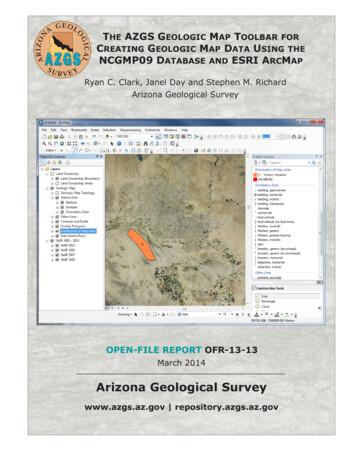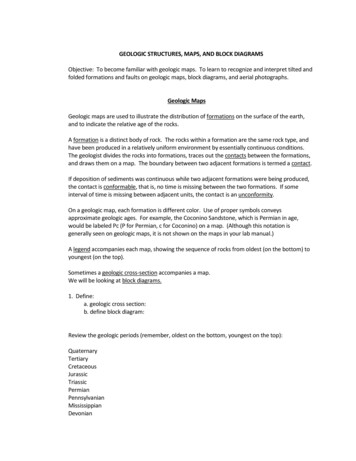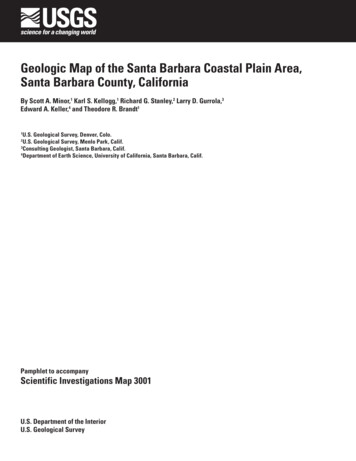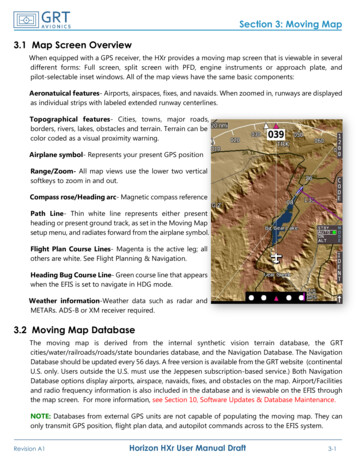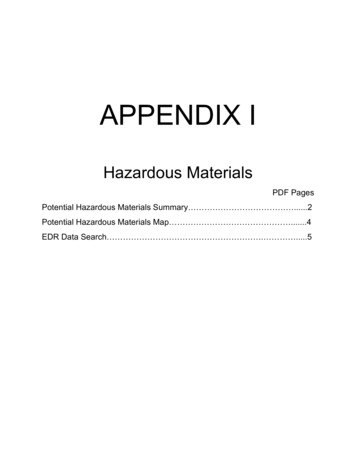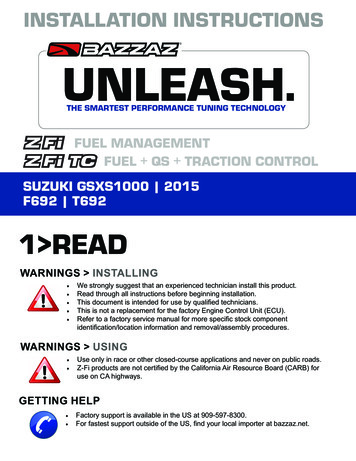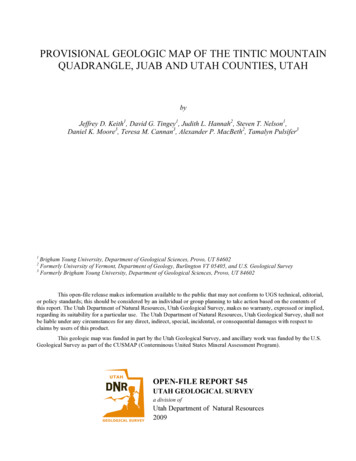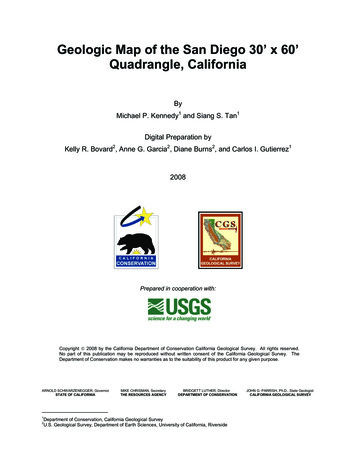
Transcription
Geologic Map of the San Diego 30’ x 60’Quadrangle, CaliforniaByMichael P. Kennedy1 and Siang S. Tan1Digital Preparation byKelly R. Bovard2, Anne G. Garcia2, Diane Burns2, and Carlos I. Gutierrez12008Prepared in cooperation with:Copyright 2008 by the California Department of Conservation California Geological Survey. All rights reserved.No part of this publication may be reproduced without written consent of the California Geological Survey. TheDepartment of Conservation makes no warranties as to the suitability of this product for any given purpose.ARNOLD SCHWARZENEGGER, GovernorSTATE OF CALIFORNIAMIKE CHRISMAN, SecretaryTHE RESOURCES AGENCYBRIDGETT LUTHER, DirectorDEPARTMENT OF CONSERVATION1Department of Conservation, California Geological SurveyU.S. Geological Survey, Department of Earth Sciences, University of California, Riverside2JOHN G. PARRISH, Ph.D., State GeologistCALIFORNIA GEOLOGICAL SURVEY
CALIFORNIA GEOLOGICAL SURVEYJOHN G. PARRISH, Ph.D.STATE GEOLOGISTCopyright 2008 by the California Department of Conservation.All rights reserved. No part of this publication may be reproducedwithout written consent of the California Geological Survey.The Department of Conservation makes no warranties as to thesuitability of this product for any particular purpose.
relatively narrow, westward sloping coastalmargin that includes the San Diegoembayment. On the east the highlands arebounded from the adjoining Colorado Desertand the Gulf of California by precipitous faultscarps, 2,000 to more than 3,000 meters high.The area within the San Diego 30’ x 60’quadrangle is tectonically and seismicallyactive and includes parts of four ike-slip, Pacific/North American Plateboundary fault zones. They include the RoseCanyon-Newport-Inglewood Fault Zone alongthe eastern coastal margin of the quadrangle,the Palos Verdes-Coronado Bank Fault Zoneoffshore on the inner shelf, the San DiegoTrough Fault Zone (source of the 1986,ML 5.3, Oceanside earthquake) in the centraloffshore region, and the San Clemente FaultZone on the outer offshore margin (Fig. 1).Within the greater San Diegometropolitan area, the Rose Canyon FaultZone, as depicted by Kennedy and others(1975), Moore and Kennedy (1975), Kennedyand Welday (1980), Clarke and others (1987),Treiman (1993) and Kennedy and Clarke(2001), includes the Mount Soledad, OldTown, Point Loma, Silver Strand, Coronadoand Spanish Bight faults. The Rose CanyonFault Zone displaces Holocene sediment inRose Canyon 7 km north of San Diego Baywhere a late Pleistocene slip rate of 1-2mm/yr has been estimated (Lindvall andRockwell, 1995). A study of the recency andcharacter of faulting in the greater San Diegometropolitan area suggests a long-termTertiary slip rate for the Rose Canyon FaultZone of about 1-2 mm/yr (Kennedy andothers, 1975). Although there is significantlate Quaternary deformation in the San Diegoregion the seismicity is relatively low (Simons,1977).The eastern part of the San Diego1:100,000-scale quadrangle is underlain byplutonic rocks of the western PeninsularRanges batholith and a thick sequence ( 5km) of Mesozoic fore-arc and fore-arc basinvolcanic and volcaniclastic deposits. TheIntroductionIn 1990 the U.S. Geological Survey,as part of the National Geologic MappingProgram, initiated the Southern CaliforniaAreal Mapping Project (SCAMP) (http://scamp.wr.usgs.gov) in cooperation with theCalifornia Geological Survey (then Divisionof Mines and Geology) Regional GeologicMapping Project .htm). SCAMP’sobjectives were two-fold: to provide a basicunderstanding of the geologic frameworkand geologic history of southern California;and to develop a uniform digital geologicmap database that could be used in aGeographic Information System (GIS) andbe the foundation for geologic hazardinvestigations, natural resource evaluations,and other related earth science studies.These types of digital data can provide animportant component for performing GISanalyses throughout southern California.This map was prepared by theDepartment of Conservation, CaliforniaGeological Survey and is a product ofSCAMP. This project was supported in partby the U.S. Geological Survey STATEMAPaward no. 98HQAG2049.Geologic SummaryThe San Diego 1:100,000-scalequadrangle lies within the PeninsularRanges Geomorphic Province of southernCalifornia, between 32 30’ and 33 N.latitude and 117 and 118 W. longitude,and encompasses the greater San Diegoarea, the second largest metropolitan areaof California (Fig. 1).The PeninsularRanges of southern California form anorthwest-trending geomorphic provincethat occupies the southwestern corner ofCalifornia and extends southeastward toform the Baja California peninsula. Itsphysiography is characterized principally bysteep mountain highlands with elevationsexceeding 3,500 meters and dramaticintermontane basins, valleys, and rivers.The highlands are flanked on the west by a1
Figure 1. Index map showing the location of the San Diego 30’ x 60’ quadrangle, majorcities and faults, as well as the geomorphic provinces of southwestern California.Modified from Jennings and Saucedo, 2002.batholithic rocks are mostly granodiorite andtonalite (Fig. 2) and based on U/Pb isotopicages range from 140 Ma to 105 Ma (Silverand Chappell, 1988). The andesitic flowsand coarse-grained volcaniclastic breccias ofthe Mesozoic fore-arc deposits have, in largepart, been metamorphosed to low-gradegreenschist facies and exhibit penetrativedeformation. However, in the upper part ofthe section these rocks are not metamorphosed and are only moderately deformed. Marine sedimentary interbeds inPenasquitos Canyon, near Del Mar, containthe fossil Buchia piochii, which indicates aLate Jurassic (Tithonian) age for these strata(Fife and others, 1967; Jones and Miller,1982).Zircon U/Pb ages from themetavolcanic rocks are reported to rangefrom 137 Ma to 119 Ma (Anderson, 1991)indicating that they are coeval with thesurrounding plutonic rocks of the westernPeninsular Ranges batholith. Much of the2
700 meters thick and grades from nonmarine fan and dune deposits on the eastthrough lagoonal and nearshore beach andbeach-bar deposits to marine continentalshelf deposits on the west near the presentday coastline. The age and environmentalinterpretation of the Eocene sequence isbased on the mapped distribution of lithofacies coupled with the presence of a pelagicfossil calcareous nannoplankton flora in thecontinental shelf facies (e.g., Bukry andKennedy, 1969), a shallow water molluscanfauna in the nearshore facies (e.g., Givensand Kennedy, 1979), and a fossil terrestrialvertebrate mammal fauna in the paralicfacies (e.g., Golz, 1973). Cross bedding,cobble imbrications, paleostream gradientsand clast petrology indicate a local easternsource for these rocks. The nonmarinefacies of the Eocene formations are typicallywell indurated and cemented whereas thelagoonal facies are soft and friable. Thenearshore facies are well indurated, wellsorted, and locally concretionary.Themarine deposits are typically fine-grained,indurated, and cemented. Following thedeposition of Eocene rocks, the San Diegomargin was again elevated and eroded.During the Oligocene, continental andshallow water lagoonal deposits of the OtayFormation were deposited.The OtayFormation is light-gray and light-brown,medium- and coarse-grained, arkosicsandstone intertongued with light-brownsiltstone and light-gray claystone. Much ofthe claystone is composed of light-graybentonite in beds up to 1 m in thickness.Following Oligocene time, the San Diegocoastal margin underwent uplift andextensive erosion. The next major marinetransgression did not occur until Pliocenetime when the strata of the San DiegoFormation were deposited. The San DiegoFormationrestsunconformablyuponOligocene, Eocene, and Upper Cretaceousbeds across its outcrop from Pacific Beachto the International border with Mexico. TheSan Diego Formation is late Pliocene in agebasement rock has been deeply weatheredand altered. The weathered bedrock andQuaternary alluvial deposits derived fromthem contain expansible clays, mostlysmectite.The western part of the quadrangle isunderlain by a relatively thick ( 1,000 m)succession of Upper Cretaceous, Tertiaryand Quaternary sedimentary rocks thatunconformably overlie basement rocks.They consist of marine, paralic, andcontinental claystone, siltstone, sandstoneand conglomerate. The Upper Cretaceousrocks are composed of marine turbidites andcontinental fan deposits assigned to theRosario Group (Kennedy and Moore, 1971).The Lusardi Formation, the basal formationof the Rosario Group, is a nonmarineboulder fanglomerate deposited along thewestern margin of a tectonic highland upon adeeply weathered surface of the olderCretaceous and Jurassic plutonic andmetamorphic basement rocks. Clasts withinthe Lusardi Formation are composedexclusively of these weathered basementrocks. The Lusardi Formation is overlain bythe Point Loma Formation, the middle part ofthe Rosario Group. It is composed mostly ofmarine sandstone, siltstone and conglomerate sequences that together formmassive turbidite deposits. The Point LomaFormation is Campanian and Maestrichtianin age (Sliter, 1968; Bukry and Kennedy,1969) and underlies most of the Point LomaPeninsula and the hills southeast of La Jolla.It is conformably overlain by the uppermostpart of the Rosario Group, marine sandstoneand conglomerate of the Maestrichtian(Sliter, 1968; Bukry and Kennedy, 1969)Cabrillo Formation. Following the depositionof the Rosario Group, the San Diego coastalmargin underwent uplift and erosion until themiddle Eocene when nine partiallyintertonguing middle and upper Eocenesequences composed of siltstone, sandstone, and conglomerate were depositedduringseveralmajortransgressiveregressive cycles. The succession is over3
published by the California GeologicalSurvey (Division of Mines and Geology) asMap Sheet 29 (Kennedy and Tan, 1977).These published geologic maps weredigitized with minor modifications to producea seamless digital map.The original digital work for theindividual quadrangles, as well as themerged database file, was completed usingArcInfo 8.3, a commercial GIS softwarepackagebyEnvironmentalSystemsResearch Institute (ESRI). For publicationpurposes the merged coverage wasconverted into the ESRI geodatabaseformat. The merged geology, structure, andannotation files along with base layers andshaded-relief images were combined usingthe ArcMap application within ArcInfo 9.1(ESRI).An effort was made to apply thecurrently accepted standards for unitdesignations and colors to the geologic map(http://ngmdb.usgs.gov/fgdc gds/). On thegeologic map Quaternary sedimentary rocksare shown in shades of yellow and gold,Tertiary sedimentary rocks are depicted inshades of brown and reddish-brown, whileCretaceous sedimentary rocks and Jurassicmetasedimentary rocks are shown in shadesof green. Volcanic rocks are depicted inshades of orange while plutonic rocks areshown in shades of pink or purple, withpurple designating more mafic units.and contains a rich molluscan fauna (e.g.,Arnold, 1903; Demere, 1983). It consistsmostly of yellowish-brown and gray, fine- tomedium-grained, marine sandstone andreddish-brown, transitional marine andnonmarine pebble and cobble conglomerate.Following the deposition of the San DiegoFormation and continuing today, the SanDiego coastal margin has undergonerelatively steady uplift.A series ofcontinuallyevolvingmarineabrasionplatforms have been carved and upliftedduring this time and are manifest in themarine terraces and their deposits that areubiquitous to the San Diego coastal region(Plate 2). The deposits consist of nearshoremarine, beach, estuarine, lagoonal andcontinental dune facies that were depositedacross a marine/nonmarine transition zoneand along a coastal strandline. Changes insea level coupled with regional uplift giverise to the preservation and/or obliteration ofboth the abrasion platforms and theiroverlying deposits (e.g. Lajoie, and others,1991; Kern and Rockwell, 1992; Kern,1996a, 1996b).CompilationThe onshore part of the GeologicMap of the San Diego 30’ x 60’Quadrangle, California was digitized at ascale of 1:24,000 while the offshore part hasbeen enlarged from the 1:250,000-scaleContinental Margin Map (Clarke and others,1987) with fault additions and modificationsbased on larger scale mapping (e.g.Kennedy and others, 1980a,b; Kennedy andWelday, 1980; Kennedy and Clarke,1999a,b). Geology for the seven 7.5-minutequadrangles onshore was compiled frompublished geologic mapping (Fig. 3).Geologic maps of the Del Mar, La Jolla,Point Loma, La Mesa, and Poway quadrangles were published by the CaliforniaGeological Survey (Division of Mines andGeology) as Bulletin 200 (Kennedy, 1975;Kennedy and Peterson, 1975). The NationalCity and Imperial Beach quadrangles wereBase MaterialThe base for the San Diego 30’ x 60’quadrangle consists of shaded-relief andtopographic digital data.The onshoreportion of the base consists of hypsography,transportation, hydrography, and place namelayers. The hypsography and transportationlayers were converted from 1:100,000 DigitalLine Graph (DLG) data into ArcInfo coverages and then into ESRI geodatabasefeature classes. The DLG data is availablefrom the USGS Geographic Data Downloadwebsite at http://edc2.usgs.gov/geodata/The hydrography layers areindex.php.4
derived from data obtained from the NationalHydrography Dataset at http://nhd.usgs.gov/data.html. Place names were generatedfrom data obtained from the U.S. Board onGeographic Names GNIS website athttp://geonames.usgs.gov/domestic/download data.htm. Carlos Gutierrez (CGS)generated the onshore shaded-relief imagefrom 30-meter resolution elevation dataobtained from the National Elevation Dataset(NED) at http://ned.usgs.gov/. The offshoreshaded-relief image was prepared by PeterDartnell (USGS) from multibeam- andsinglebeam-bathymetry data acquired byFederal and local agencies as well asacademicinstitutionsincluding:U.S.Geological Survey - http://pubs.usgs.gov/of/2004/1221/; Woods Hole OceanographicInstitution and SCRIPPS Institution ofOceanography - html; CaliforniaState University, Monterey Bay - http://seafloor.csumb.edu/SFMLwebDATA.htm;the National Oceanic and AtmosphericAdministration - ;andtheCalifornia Coastal Conservancy, San DiegoAssociation of Governments (SANDAG),California Department of Fish and Game,and Fugro Pelagos.AcknowledgementsThis compilation was the result of acollaborative effort between the CaliforniaGeological Survey and the U.S. GeologicalSurvey. The authors wish to thank J.P.Kern, D.M. Morton, G.J. Saucedo, and V.R.Todd for their valuable reviews. We wouldalso like to thank Carlos Gutierrez, KarenToman-Sager, and Heather Lackey for theirassistance in the preparation of this map forpublication.5
Qmo Undivided marine deposits inoffshore region (late Holocene) –Unconsolidated, often ponded marine sediments. Composed mostlyof very fine- to medium-grainedsand and silt.DESCRIPTION OF MAP UNITSApproximate stratigraphic relationships;see Plate 2 for detailed correlation.MODERN SURFICIAL DEPOSITSSediment that recently has beentransported and deposited in channelsand washes, on surfaces of alluvialfans and alluvial plains, and on hillslopes and in artificial fills. Soil-profiledevelopment is nonexistent. Includes:afArtificial fill (late Holocene) –Deposits of fill resulting from humanconstruction, mining, or quarryingactivities;includescompactedengineered and non-compacted,non-engineered fill. Some largedeposits are mapped, but in someareas no deposits are shown.QwWash deposits (late Holocene) –Unconsolidated bouldery to sandyalluvium of active and recentlyactive washes.QlsLandslide deposits, undivided (Holocene and Pleistocene) – Highlyfragmented to largely coherentlandslide deposits. Unconsolidatedto moderately well consolidated.Most mapped landslides containscarp area as well as slide deposit.Many Pleistocene age landslideswere reactivated in part or entirelyduring late Holocene.QcfYOUNG SURFICIAL DEPOSITSSedimentary units that are slightlyconsolidated to cemented and slightlyto moderately dissected. Alluvial fandeposits typically have high coarsefine clast ratios. Young surficial unitshave upper surfaces that are cappedby slight to moderately developedpedogenic soil profiles. Includes:Qmb Marine beach deposits (late Holocene) – Unconsolidated beachdeposits consisting mostly of fineand medium-grained sand.QpeCanyon fill deposits in offshoreregion (late Holocene) – Unconsolidated deposits of mixed gravel,sand, and mud on the canyon floor.QyaYoung alluvial flood-plain deposits(Holocene and late Pleistocene) –Poorly consolidated, poorly sorted,permeable flood-plain deposits ofsandy, silty or clay-bearing alluvium.QycYoung colluvial deposits (Holocene and late Pleistocene) –Poorly consolidated and poorlysorted sand and silt slope washdeposits.QctUndivided canyon terrace depositsin offshore region (Holocene andPleistocene) – Unconsolidateddeposits of mixed gravel, sand, andmud on canyon formed terrace.OLD SURFICIAL DEPOSITSSediments that are moderately consolidated and slightly to moderatelydissected. Older surficial depositshave upper surfaces that are cappedby moderate to well-developedpedogenic soils. Includes:Paralic estuarine deposits (late Holocene) – Unconsolidated estuarinedeposits. Composed mostly of finegrained sand and clay.6
QoaOld alluvial flood-plain deposits,undivided(latetomiddlePleistocene) – Fluvial sedimentsdepositedoncanyonfloors.Consists of moderately well consolidated, poorly sorted, permeable,commonly slightly dissected gravel,sand,silt,andclay-bearingalluvium.QopOld paralic deposits, undivided(late to middle Pleistocene) –Poorly sorted, moderately permeable, reddish-brown, interfingeredstrandline, beach, estuarine andcolluvial deposits composed of siltstone, sandstone and conglomerate. These deposits rest on thenow emergent wave cut abrasionplatforms preserved by regionaluplift (Plate 2). Where more thanone number is shown (e.g., Qop2-4),those deposits are undivided.Includes:permeable, reddish-brown, interfingered strandline, beach, estuarine and colluvial deposits composed of siltstone, sandstone andconglomerate. In much of the area,marine terraces and their paralicdeposits cannot be divided as theymerge with and are alternatelycovered by one another. Theirphysical and temporal relationshipsare diagrammatically illustrated inPlate 2.VERY OLD SURFICIAL UNITS Sediments that are slightly to wellconsolidated to indurated, and moderately to well-dissected. Upper surfaces are capped by moderate to welldeveloped pedogenic soils. Includes:Qvoa Veryoldalluvialflood-plaindeposits, undivided (middle toearly Pleistocene) – Fluvialsediments deposited on canyonfloors. Consists of moderately towell-indurated,reddish-brown,mostly very dissected gravel, sand,silt, and clay-bearing alluvium.Qop7 Old paralic deposits, Unit 7 (late tomiddle Pleistocene) – Poorly sorted, moderately permeable, reddishbrown, interfingered strandline,beach, estuarine and colluvial deposits composed of siltstone, sandstone and conglomerate. Thesedeposits rest on the 9-11 m BirdRock terrace (Plate 2).Qvop Very old paralic deposits, undivided(middletoearlyPleistocene) – Poorly sorted, moderately permeable, reddish-brown,interfingered strandline, beach,estuarine and colluvial depositscomposed of siltstone, sandstoneand conglomerate. These depositsrest on the now emergent wave cutabrasion platforms preserved byregional uplift (Plate 2). Includes:Qop6 Old paralic deposits, Unit 6 (late tomiddle Pleistocene) – Poorlysorted,moderatelypermeable,reddish-brown, interfingered strandline, beach, estuarine and colluvialdeposits composed of siltstone,sandstoneandconglomerate.These deposits rest on the 22-23 mNestor terrace (Plate 2).Qvop13 Very old paralic deposits, Unit 13(middle to early Pleistocene) –Poorly sorted, moderately permeable,reddish-brown,interfingered strandline, beach, estuarine and colluvial deposits composed of siltstone, sandstone andQop2-4 Old paralic deposits, Units 2 - 4 undivided (late to middle Pleistocene) – Poorly sorted, moderately7
Qvop10a Very old paralic deposits, Unit 10a(middle to early Pleistocene) –Poorly sorted, moderately permeable, reddish-brown, dune andback beach "beach ridge" depositscomposed of cross-bedded sandstone. The ridge is a conspicuouslinear topographic high that hasformed along a strandline, on andas a part of Qvop10.conglomerate. These deposits reston the 67-69 m San Elijo terrace(Plate 2).Qvop12 Very old paralic deposits, Unit 12(middle to early Pleistocene) –Poorly sorted, moderately permeable,reddish-brown,interfingered strandline, beach, estuarine and colluvial deposits composed of siltstone, sandstone andconglomerate. These deposits reston the 83-85 m Fire Mountainterrace (Plate 2).Qvop9 Very old paralic deposits, Unit 9(middle to early Pleistocene) –Poorly sorted, moderately permeable,reddish-brown,interfingered strandline, beach, estuarine and colluvial deposits composed of siltstone, sandstone andconglomerate. These deposits reston the 113-115 m Linda Vistaterrace (Plate 2).Qvop11 Very old paralic deposits, Unit 11(middle to early Pleistocene) –Poorly sorted, moderately permeable,reddish-brown,interfingered strandline, beach, estuarine and colluvial deposits composed of siltstone, sandstone andconglomerate. These deposits reston the 92-94 m Clairemont terrace(Plate 2).Qvop9a Very old paralic deposits, Unit 9a(middle to early Pleistocene) –Poorly sorted, moderately permeable, reddish-brown, dune andback beach "beach ridge" depositscomposed of cross-bedded sandstone. The ridge is a conspicuouslinear topographic high that hasformed along a strandline, on andas a part of Qvop9.Qvop11a Very old paralic deposits, Unit 11a(middle to early Pleistocene) –Poorly sorted, moderately permeable, reddish-brown, dune andback beach "beach ridge" depositscomposed of cross-bedded sandstone. The ridge is a conspicuouslinear topographic high that hasformed along a strandline, on andas a part of Qvop11.Qvop8 Very old paralic deposits, Unit 8(middle to early Pleistocene) –Poorly sorted, moderately permeable,reddish-brown,interfingered strandline, beach, estuarine and colluvial deposits composed of siltstone, sandstone andconglomerate. These deposits reston the 123-125 m Tierra Santaterrace (Plate 2).Qvop10 Very old paralic deposits, Unit 10(middle to early Pleistocene) –Poorly sorted, moderately permeable,reddish-brown,interfingered strandline, beach, estuarine and colluvial deposits composed of siltstone, sandstone andconglomerate. These deposits reston the 104-106 m Tecolote terrace(Plate 2).Qvop8a Very old(middlePoorlymeable,8paralic deposits, Unit 8ato early Pleistocene) –sorted, moderately perreddish-brown, dune and
back beach "beach ridge" depositscomposed of cross-bedded sandstone. The ridge is a conspicuouslinear topographic high that hasformed along a strand line, on andas a part of Qvop8.on the 170-174 m Aqueduct terrace(Plate 2).Qvop3 Very old paralic deposits, Unit 3(middle to early Pleistocene) –Poorly sorted, moderately permeable,reddish-brown,interfingered strandline, beach, estuarine and colluvial deposits composed of siltstone, sandstone andconglomerate. These deposits reston the 181-185 m Aliso Canyonterrace (Plate 2).Qvop7 Very old paralic deposits, Unit 7(middle to early Pleistocene) –Poorly sorted, moderately permeable,reddish-brown,interfingered strandline, beach, estuarine and colluvial deposits composed of siltstone, sandstone andconglomerate. These deposits reston the 129-131 m Mira Mesaterrace (Plate 2).Qvop2 Very old paralic deposits, Unit 2(middle to early Pleistocene) –Poorly sorted, moderately permeable,reddish-brown,interfingered strandline, beach, estuarine and colluvial deposits composed of siltstone, sandstone andconglomerate. These deposits reston the 190-194 m Flores Hill terrace(Plate 2).Qvop6 Very old paralic deposits, Unit 6(middle to early Pleistocene) –Poorly sorted, moderately permeable,reddish-brown,interfingered strandline, beach, estuarine and colluvial deposits composed of siltstone, sandstone andconglomerate. These deposits reston the 139 m Black Mountainterrace (Plate 2).Qvop1 Very old paralic deposits, Unit 1(middle to early Pleistocene) –Poorly sorted, moderately permeable,reddish-brown,interfingered strandline, beach, estuarine and colluvial deposits composed of siltstone, sandstone andconglomerate. These deposits reston the 201-205 m Eagle terrace(Plate 2).Qvop5 Very old paralic deposits, Unit 5(middle to early Pleistocene) –Poorly sorted, moderately permeable,reddish-brown,interfingered strandline, beach, estuarine and colluvial deposits composed of siltstone, sandstone andconglomerate. These deposits reston the 153-157 m Rifle Rangeterrace (Plate 2).SEDIMENTARY AND VOLCANICBEDROCK UNITSQTso Undivided sediments and sedimentary rocks in offshore region(Holocene, Pleistocene, Plioceneand Miocene) – Unconsolidatedand poorly consolidated Pleistocenesand, silt and clay deposits thatmantle the modern seafloor.Includes unmapped sandstone,siltstone, conglomerate and breccia.Qvop4 Very old paralic deposits, Unit 4(middle to early Pleistocene) –Poorly sorted, moderately permeable,reddish-brown,interfingered strandline, beach, estuarine and colluvial deposits composed of siltstone, sandstone andconglomerate. These deposits rest9
TmoTsd San Diego Formation (early PleistoTsdss cene and late Pliocene)–TsdcgPredominantlyyellowish–brownand gray, fine- to medium-grained,poorly indurated fossiliferous marinesandstone (Tsdss) and reddishbrown, transitional marine andnonmarine pebble and cobbleconglomerate (Tsdcg). In part ofthe area the sandstone and conglomerate are undivided (Tsd). TheSan Diego Formation consists ofapproximately 75 m of marine and 9m of nonmarine sedimentary rocks(Demere, 1983). These rocks andtheir associated marine fossils werefirst described by Dall (1898) andgiven the name "San Diego Beds."The name San Diego Formationwas given to these rocks in anextensive biostratigraphic study byArnold (1903). Several comprehensive studies of the marineinvertebrate fossil faunas of the SanDiegoFormationhavebeenpublished subsequently by Grantand Gale (1931) and Hertlein andGrant (1944, 1960, 1972). Mostrecently Demere (1982, 1983)presents a concise discussion onthe history of work, geologic setting,biostratigraphy and age of the SanDiego Formation.TbaUndivided sedimentary rocks inoffshore region (Miocene) –Consistsprimarilyofwellconsolidated, bedded sandstoneand siltstone.Tmvo Undividedvolcanicrocksinoffshore region (Miocene) –Consists primarily of dark-gray andblack basaltic rock.Tmuo Undivided volcanic and sedimentary rocks in offshore region(Miocene) – includes Tmo – wellconsolidated, bedded sandstoneand siltstone; or Tmvo – dark-grayand black basaltic rock.Basaltic-andesite dike (Miocene) –Black, fine-grained, massive, veryfresh, basaltic-andesite dike locatedapproximately 600 m north of theScripps Institution of Oceanographypier. A whole-rock potassium-argonanalysis of this rock, which showssome evidence of wall rockassimilation, gave an approximateage of 11 Ma (J.W. Hawkins, writtencommunication, 1972).10ToOtay Formation (late Oligocene) –Light-gray and light-brown, mediumand coarse-grained, nonmarinearkosic sandstone intertongued withlight-brown siltstone and light-grayclaystone. Much of the claystone iscomposed of light-gray bentonitethat occurs in beds up to 1 m inthickness. A rich vertebrate fossilassemblagefromtheOtayFormation yields an ArikareeanNorth American mammal "age"(Walsh and Demere, 1991). An40Ar/39Ar date of 28.86 Ma from abentonite bed within the upper partof the Otay Formation has beenprovided by J.D. Obradovich of theU.S.GeologicalSurveyandreported in Berry (1991). Berry(1991) provides an excellentsummary of the bentonite claydeposits of the Otay Formation.TpTpmPomerado Conglomerate (middleEocene)–Massivecobbleconglomerate with a dark-yellowishbrown, coarse-grained sandstonematrix (Tp) and an intervening, 10m thick, light-olive-gray, soft andfriable, fine- to medium-grained
sandstone tongue designated theMiramar Sandstone Member of thePomerado Conglomerate (Tpm).The Pomerado Conglomerate is theupper-most formation of the PowayGroup, and has a thickness of 56 mat its type section. Sandstone bedswithin the Pomerado Conglomerateand Miramar Sandstone Membercontain a middle Eocene (lateUintan) vertebrate fossil assemblage (Walsh and others, 1996).The Pomerado Conglomerate wasnamed for exposures located in adivide between Carroll Canyon andPoway Valley along PomeradoRoad (Peterson and Kennedy,1974). The Miramar SandstoneMember is 10 m thick at its typesection in the vicinity of MiramarReservoir where it is lithologicallynearly identical to the MissionValley Formation but is stratigraphically higher and whollycontained within the PomeradoConglomerate(PetersonandKennedy, 1974).TmvState Highway 163 (Kennedy andMoore, 1971).Mission Valley Formation (middleEocene) – Predominantly lightolive-gray, soft and friable, fine- tomedium-grained marine and nonmarine sandstone containing cobbleconglomerate tongues. Contains adiverse late Uintan mammal fauna(Walsh and others, 1996) and arobust molluscan fauna assigned tothe Tejon stage (Givens andKennedy, 1979). A bentonite bedwithin the upper part of the MissionValley Formation yielded a singlecrystal 40Ar/39Ar date of 42.83 0.24Ma (reported in Walsh and others,1996).TheMissionValleyFormation has a maximum thickness of 60 m and was named forexposures along the south wall ofMission Valley on the west side ofTstStadium Conglomerate (middleEocene) – Massive cobble conglomerate with a dark-yellowishbrown, coarse-grained sandstonematrix. The conglomerate containsup to 85%
character of faulting in the greater San Diego metropolitan area suggests a long-term Tertiary slip rate for the Rose Canyon Fault Zone of about 1-2 mm/yr (Kennedy and others, 1975). Although there is significant late Quaternary deformation in the San Diego region the seismicity is relatively low (Simons, 1977). The eastern part of the San Diego


